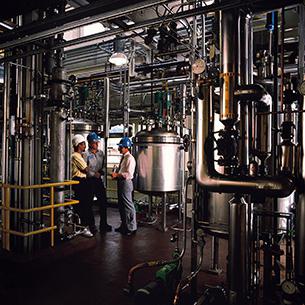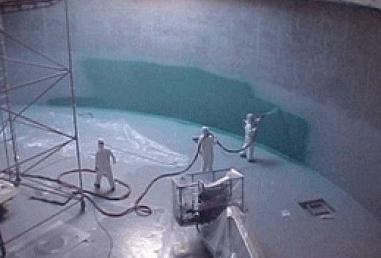All metal structures that are used in construction should have reliable protection against the effects of various environmental factors, and first of all, from corrosion. What materials are used for this? We will clarify further.
General information
Corrosion is a physicochemical process in which metal interacts with the environment. During this reaction, the properties of the material change. As a result of such processes, it begins to collapse.
Corrosion-resistant protective coatings
They are used to process elements in order to prevent their destruction. Corrosion-resistant coating, presented in the form of special enamels or paints, has several advantages in comparison with other materials having similar properties. Among the main advantages of such products should be noted:
- Ability to handle large-sized structures and elements of complex configuration.
- Ease of application.
- Profitability, the possibility of recovery during operation.
- Relatively affordable cost in comparison with other materials.
- An opportunity to receive a different color of a covering.
The most common formulations
Corrosion-resistant coating of metal structures for many manufacturing companies is the main activity. Various materials are used to process structures and elements. Among them are:
- Paint "Stainless". This enamel can be used both on clean surfaces and those coated with rust.
- Paint "stainless steel". This composition has high adhesion. This paint is used for decorative and protective processing of surfaces from lead, duralumin, aluminum, brass, titanium, copper and zinc.
- Paint "Aquametallic" - water-based acrylic composition.
- The mixture "Fastmetr" is a quick-drying paint.
- Urethane enamel "Polymeron". This composition is characterized by high wear resistance.
- Paint "Tsikrol". It is used in the processing of roof structures, galvanized elements.
- Composition "Serebrol". This anti-corrosion coating for metal has a silver-white color.
- Decorative enamel "stainless steel". It is a liquid plastic.
- "Molotex" - is a hammer paint.
- "Nerzamet-aerosol" - is available in spray cans.
- "Phosphogrunt" - used for non-ferrous and ferrous metals.
- "Phosphomet" - is a phosphating modifier, a rust converter.
How is anti-corrosion coating of pipelines carried out? To process such elements are used:
- "Stainless". This anti-corrosion coating of pipelines is a chemically resistant vinyl primer-enamel.
- "Polyurethol" - a polyurethane oil and petrol-resistant mixture.
- "Epostat" - an epoxy chemically resistant anticorrosive coating of pipes (primer-enamel).
- "Zincolol" - a polyurethane zinc-filled primer.
Mixture "Urizol"
With this composition, corrosion-resistant coating of pipes transporting oil products, oil itself and natural gas is carried out. This mixture processes fittings, crane assemblies, fittings. The composition is used for protection against atmospheric and underground corrosion of pipelines of pumping, compressor, pumping gas distribution stations, head structures, oil depots, integrated treatment plants and raw material storage facilities, as well as other similar structures, the operating temperature of which is up to 60 degrees. The Urizol mix is also used for insulation of piles and other concrete elements.
Features of the composition
First of all, it should be noted the ease and simplicity of applying the mixture. For processing, as a rule, a spray is used. From the moment the components are combined, a reaction begins during which polyurea is formed. Further, the system passes from a liquid to a non-fluid gel-like state, and then to a solid state. If the polymerization rate is not high enough, smudges will form. They, in turn, impede the necessary increase in coating thickness. At the same time, stickiness will remain for a long period. It prevents the implementation of intermediate control measurements of the thickness and uniformity of the layer. If the polymerization rate is too high, the adhesion of the composition to the surface is reduced. Moreover, the thickness of the insulation is uneven. In this case, the spray gun becomes clogged quite quickly. To prevent such situations, careful selection of the components of the composition and the preparation of the mixture in accordance with the instructions are necessary.

Some recommendations
All components of the Urizol mixture are delivered in special steel barrels. Storage of material is carried out indoors, in airtight containers. High-quality mixing of the components is carried out using special equipment - a two-component spray installation. It provides accurate dosing of ingredients in a 1: 1 ratio. At the same time, the necessary pressure (at least 150 atmospheres) and temperature (60-80 degrees) are maintained. Spraying is carried out in a thin layer. Before application, the components are premixed in a container. To do this, the barrels roll and shake.
Composition benefits
Urizol coating, unlike many other polymer blends that contain one or another amount of organic volatile solvents, is a composition that includes one hundred percent of the solid phase. Polyurea does not contain plasticizers, which are prone to sweating over time. This process is accompanied by a gradual shrinkage and an increase in the fragility of the protective film. The mixture does not include tar and coal components, often added to reduce the cost of the material, but with a carcinogenic effect on the human body. In addition, the composition lacks solid fillers that provoke abrasive wear of pumping equipment, nozzles in spraying plants and mixing chambers. Due to their high reactivity, polyurea components have a high level of polymerization without catalysts. The increased reliability of the coating is also due to the relatively low sensitivity to temperature and humidity differences. For example, other polyurethane mixtures of similar action have a higher tendency to form a porous film under the influence of moisture, which, in turn, is always present in the initial components of the raw material. However, it should be noted that the reliability of polyurea is ensured only with careful observance of the requirements for the preparation of the treated structures and elements.

Anti-corrosion coating
The processing process includes several stages. First of all, it should be noted that applying a corrosion-resistant coating is a rather difficult job. The final result will depend on the thoroughness of the preparation of the elements and the quality of the composition used. The greatest difficulty is usually the anti-corrosion coating of the bottom of any structure. Next, we consider the main stages of work.
Visual inspection
Before you carry out anti-corrosion coating of metal structures, it is necessary to assess their condition. This is done by specialists in this field. During the visual inspection, the degree of surface damage is determined. Based on the results of the assessment, an estimate is made. In the course of this work, various factors are taken into account. These, in particular, include the temperature regime in which the operation of the structure takes place. As well as the influence of atmospheric phenomena and other aggressive environments, the intended purpose of the elements, the type of material that was used in their manufacture. In accordance with this, one or another anti-corrosion coating of the metal will be selected. For processing large-sized structures, as a rule, special equipment is required.
Surface preparation
Before using a corrosion-resistant coating, the surface of the structure or element should be cleaned. In the process of preparation, contaminants of various origins, old paint are removed. Object cleaning can be carried out by hydroabrasive, hydrodynamic, abrasive-jet method. Then it is necessary to degrease the surface. For this, hydrocarbon solvents are used. At the end of this stage, the surface of the structure is inspected again.
Treatment
Corrosion-resistant coating is used under certain conditions. Immediately before processing, the composition is prepared in accordance with the technology. As a rule, the procedure is carried out by airless method. This is due to the greatest effectiveness of this method. Corrosion-resistant coating is carried out in several layers. In this case, before applying the next, the previous one must dry to one degree or another (information on this is contained in the instructions for use).
Final stage
After the anticorrosion coating of the metal is completed, a control inspection of the structure or element is carried out. When assessing the quality of the work performed, special equipment can also be used. As a result of the inspection, the presence or absence of untreated areas or defects is revealed. The level of adhesion of the composition to the surface and the decorative properties of the coating are also evaluated. In addition, it is important to determine the thickness of the dry film. The optimal value is 240-300 microns. As mentioned above, such processes are carried out by specialists. At the end of processing, the customer accepts the object. However, he also receives all the necessary documentation.